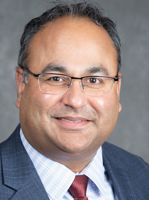Regina Schaffer , 2025-04-17 13:56:00
April 17, 2025
4 min read
Key takeaways:
- Select adults with ischemic heart failure with reduced ejection fraction may derive benefit from an investigational cell therapy.
- A new trial will commence for patients with HFrEF and elevated NT-proBNP.
CHICAGO — An autologous point-of-care cell therapy for adults with ischemic HF with reduced ejection fraction was safe and may be beneficial for select candidates, though a pivotal study did not meet its primary efficacy outcome.
New 2-year data from the CardiAMP-HF trial, presented at the American College of Cardiology Scientific Session, suggest that the first cardiac cell therapy utilizing precision medicine may be beneficial for patients with HFrEF with elevated baseline levels of N-terminal pro-B-type natriuretic peptide, who experienced reduced risk for CV death, major adverse CV events and improved quality of life metrics compared with patients who received guideline-directed medical therapy alone. The CardiAMP-HF trial of the autologous bone marrow mononuclear cell therapy (CardiAMP, BioCardia) was stopped early because of slow enrollment and low event rates.
“Cell therapy has been tested in a variety of scenarios, including MI and congestive HF, and in patients with chronic HF, there have been some signals suggesting benefit,” Amish N. Raval, MD, FACC, professor of medicine at the University of Wisconsin School of Medicine and Public Health, told Healio. “Among the ischemic HFrEF population, not everyone is the same. Some people carry certain cell populations, such as CD34, that have more favorable properties, and injecting cell therapy in those patients could be beneficial.”
Researchers analyzed data from 115 enrolled participants across 18 sites with chronic stable ischemic HFrEF, defined as NYHA class II or III with an EF between 20% and 40% on maximally tolerated guideline-directed medical therapy, whose cells met prespecified cell population thresholds based on previous studies. The mean age of participants was 66 years; 91% were men. Researchers randomly assigned participants to a single dose of cell therapy adjunctive to ongoing medical therapy or to a control sham procedure.

Amish N. Raval
“One of the novelties of this particular trial is you have a prespecified bone marrow assay that can help to identify potential responders,” Raval told Healio. “Second, this is easy to implement at the point of care once you identify the patient. It is quick and easy. You are not compromising allergenicity — if a heart transplant does end up being in the patient’s future, they’re not sensitized by allogeneic cells.”
The primary outcome was a hierarchical composite ranking of three tiers of clinical outcomes, analyzed using a win ratio Finkelstein-Schoenfeld analysis method. Tier 1 events were defined as all-cause death, heart transplantation or left ventricular assist device therapy. Tier 2 events included nonfatal HF hospitalizations, MI or stroke. The tier 3 outcome was 6-minute walk test difference from baseline to follow-up.
At 24 months, tier 1 and tier 2 primary efficacy outcomes had more wins for cell therapy compared the sham procedure; however, those wins were negated by a reduction in wins for the change in 6-minute walk test distance, resulting in a win ratio for the primary efficacy outcome of 1.01 (P = .954). There were numerically fewer major adverse CV events among participants in the cell therapy group vs. controls (20.3% vs. 31.7%), though the number did not reach statistical significance (P = .17).
Raval said there was a stronger trend toward benefit by the primary three-tier composite endpoint among participants with a baseline NT-proBNP of at least 500 pg/mL (P = .07), driven by an 86% relative risk reduction in mortality.
“That population seemed to do much better with the cell treatment vs. the control procedure treatment, with a win ratio of greater than 2,” Raval told Healio. “The [major adverse CV event] rates were 17% lower in the cell treatment group vs. the control group. That is compelling and is now the motivation of CardiAMP-HF II trial, which will study the therapy only in this population of high responders.”
There were no device-related or procedure-related deaths, strokes or systemic embolisms at 30 days; three participants developed pericardial effusions that were successfully drained, and all completed follow-up through 24 months.
Raval noted that the study protocol for the CardiAMP-HF II trial was redesigned to include the Minnesota Living with Heart Failure Questionnaire as the third-tier outcome in lieu of the 6-minute walk test and restrict enrollment to patients with an NT-proBNP level of at least 500 pg/mL. In a press release, BioCardia announced that the first study sites are now enrolling patients with ischemic HF who meet the new criteria.
“We are making incremental progress,” Raval told Healio. “As a field, we have learned so much and it is an exciting time. We are learning about patients who respond [to cell therapy] and who does not. The reality is, we do not have an answer yet regarding who is an ideal candidate for cell therapy. The CardiAMP-HF II trial will shed more light and provide greater insights into this high-responding group to help us answer this question.”

Carl J. Pepine
In a press release, Carl J. Pepine, MD, MACC, Eminent Scholar Emeritus and professor in the division of cardiovascular medicine at University of Florida, Gainesville, Chief Medical Editor Emeritus of Healio | Cardiology Today and co-principal investigator for CardiAMP-HF, said the 2-year data suggest cell therapy may have lasting benefits for the heart that may help prevent disease progression.
“It is an exciting prospect to anticipate an addition to our heart failure armamentarium that can meaningfully improve patients’ lives to an extent that many don’t enjoy today,” Pepine said in the release.
Reference:
For more information:
Amish N. Raval, MD, FACC, can be reached at anr@medicine.wisc.edu.

